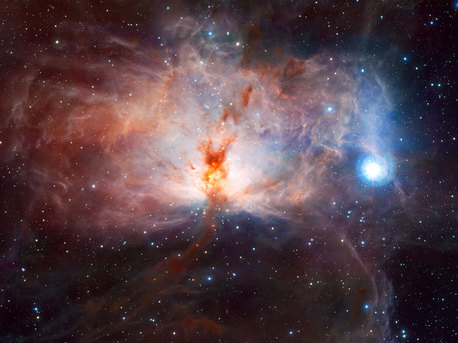New Infrared Telescope
Finally A VISTA That Works
 © ESO
|
VISTA starts mapping the southern sky.
At the heart of VISTA is a 3-tonne camera containing 16 special detectors sensitive to infrared light, with a combined total of 67 million pixels. Observing at wavelengths longer than those visible with the human eye allows VISTA to study objects that are otherwise impossible to see in visible light because they are either too cool, obscured by dust clouds or because they are so far away that their light has been stretched beyond the visible range by the expansion of the Universe. To avoid swamping the faint infrared radiation coming from space, the camera has to be cooled to -200 degrees Celsius and is sealed with the largest infrared-transparent window ever made. The VISTA camera was designed and built by a consortium including the Rutherford Appleton Laboratory, the UK ATC and the University of Durham in the United Kingdom.
Because VISTA is a large telescope that also has a large field of view it can both detect faint sources and also cover wide areas of sky quickly. Each VISTA image captures a section of sky covering about ten times the area of the full Moon and it will be able to detect and catalogue objects over the whole southern sky with a sensitivity that is forty times greater than that achieved with earlier infrared sky surveys such as the highly successful Two Micron All-Sky Survey. This jump in observational power — comparable to the step in sensitivity from the unaided eye to Galileo’s first telescope — will reveal vast numbers of new objects and allow the creation of far more complete inventories of rare and exotic objects in the southern sky.
VISTA will spend almost all of its time mapping the southern sky in a systematic fashion. The telescope is embarking on six major sky surveys with different scientific goals over its first five years. One survey will cover the entire southern sky and others will be dedicated to smaller regions to be studied in greater detail. VISTA's surveys will help our understanding of the nature, distribution and origin of known types of stars and galaxies, map the three-dimensional structure of our galaxy and the neighbouring Magellanic Clouds, and help determine the relation between the structure of the Universe and the mysterious dark energy and dark matter.
Source: ESO
New Infrared Telescope
Finally A VISTA That Works
 © ESO
|
VISTA starts mapping the southern sky.
At the heart of VISTA is a 3-tonne camera containing 16 special detectors sensitive to infrared light, with a combined total of 67 million pixels. Observing at wavelengths longer than those visible with the human eye allows VISTA to study objects that are otherwise impossible to see in visible light because they are either too cool, obscured by dust clouds or because they are so far away that their light has been stretched beyond the visible range by the expansion of the Universe. To avoid swamping the faint infrared radiation coming from space, the camera has to be cooled to -200 degrees Celsius and is sealed with the largest infrared-transparent window ever made. The VISTA camera was designed and built by a consortium including the Rutherford Appleton Laboratory, the UK ATC and the University of Durham in the United Kingdom.
Because VISTA is a large telescope that also has a large field of view it can both detect faint sources and also cover wide areas of sky quickly. Each VISTA image captures a section of sky covering about ten times the area of the full Moon and it will be able to detect and catalogue objects over the whole southern sky with a sensitivity that is forty times greater than that achieved with earlier infrared sky surveys such as the highly successful Two Micron All-Sky Survey. This jump in observational power — comparable to the step in sensitivity from the unaided eye to Galileo’s first telescope — will reveal vast numbers of new objects and allow the creation of far more complete inventories of rare and exotic objects in the southern sky.
VISTA will spend almost all of its time mapping the southern sky in a systematic fashion. The telescope is embarking on six major sky surveys with different scientific goals over its first five years. One survey will cover the entire southern sky and others will be dedicated to smaller regions to be studied in greater detail. VISTA's surveys will help our understanding of the nature, distribution and origin of known types of stars and galaxies, map the three-dimensional structure of our galaxy and the neighbouring Magellanic Clouds, and help determine the relation between the structure of the Universe and the mysterious dark energy and dark matter.
Source: ESO






